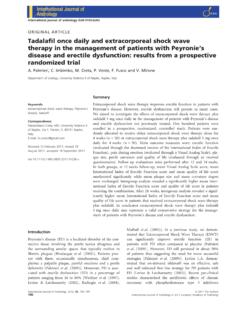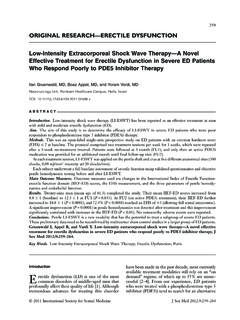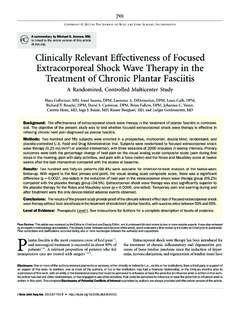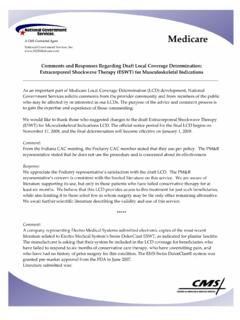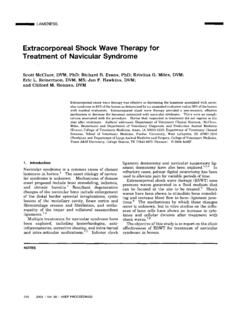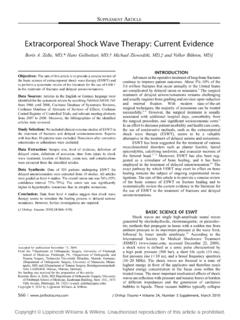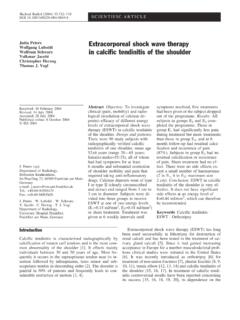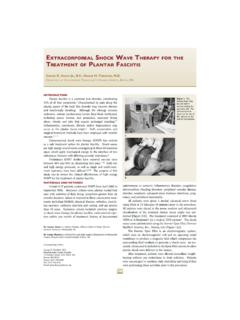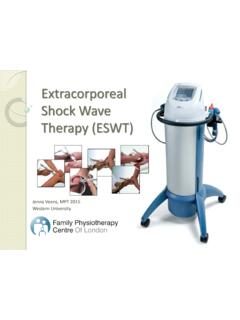Transcription of Extracorporeal Shock Wave Therapy for the Treatment of ...
1 Pelvic PainExtracorporeal Shock Wave Therapy for the Treatment of ChronicPelvic Pain Syndrome in Males: A Randomised, Double-Blind,Placebo-Controlled StudyReinhold Zimmermanna,*, Alin Cumpanasb, Florin Micleab,Gu nter JanetschekaaDepartment of Urology, Elisabethinen Hospital, University-affiliated Hospital, Linz, AustriabDepartment of Urology, Medical School, University of Timisoara, Timisoara, RomaniaEUROPEAN UROLOGY XXX(2009)XXX XXXavailable at homepage: infoArticle history:Accepted March 11, 2009 Published online ahead ofprint on March 25, 2009 Keywords:Chronic pelvic pain syndromeCPPSC hronic abacterial prostatitisShock wavesAbstractBackground:There is no sufficiently validated Therapy for chronic pelvic painsyndrome (CPPS).Objective:To investigate the effects of Extracorporeal Shock wave Therapy (ESWT)in 60 patients suffering from , setting, and (onceperweek),eachby3000impulses; ,prospectivelyrandomised,double-blindpha se2 study.
2 Standardised follow-up was performed 1, 4, and 12 wk after :Low-energy density ESWT was performed using a perinealapproach without anaesthesia. In the placebo group, the same setting was usedwithout Shock wave energy :ESWT effects on pain, quality of life (QoL), erectile function (EF),and micturition were evaluated. The parameters were investigated using validatedquestionnaires (National Institutes of Health Chronic Prostatitis Symptom Index[NIH-CPSI], International Prostate Symptom Score [IPSS], International Index ofErectile Function [IIEF]) and the Visual Analog Scale (VAS) for pain and limitations:All patients completed outpatient treatments and follow-ups without any problems. All 30 patients in the verum group showed statistically(highly) significant improvement of pain, QoL, and voiding conditions followingESWT in comparison to the placebo group, which experienced a continuousdeterioration of the same parameters during the follow-up period.
3 Perineal ESWTwas easy and safe to perform without anaesthesia or any :This is the first prospectively randomised, double-blind study toreveal perineal ESWT as a Therapy option for CPPS with statistically significanteffects in comparison to placebo. ESWT may in particular be interesting because ofits easy and inexpensive application, the lack of any side-effects, and the potentialfor repetition of the Treatment at any time.#2009 European Association of Urology. Published by Elsevier All rights reserved.* Corresponding author. Department of Urology, Elisabethinen Hospital, Fadinger Str. 1, 4010 Linz,Austria. Tel. +43 732 7676 4550; Fax: +43 732 7676 Zimmermann).EURURO-2972; No of Pages 7 Please cite this article in press as: Zimmermann R, et al., Extracorporeal Shock Wave Therapy for the Treatment of Chronic PelvicPain Syndrome in , Eur Urol (2009), $ see back matter#2009 European Association of Urology.
4 Published by Elsevier All rights reserved. incidence of chronic pelvic pain syndrome (CPPS) isincreasing[1,2], and the vast majority of male patientssuffer from this abacterial form[3,4]. Recently, anincidence of almost 14% was found among>5000 maleurologic outpatients, whereas incidence had been esti-mated to be only [5]. The disease reveals substantialmorbidity comparable to that of angina pectoris, Crohn sdisease, or the status after a heart attack. Disease-typicalrestrictions are pain sensations most commonly in theprostate, testes, groin, back, pelvic floor, and suprapubicregion[6].The functional CPPS-like symptoms, such as distur-bances of micturition and erectile function (EF), can have acrucial diminishing effect on quality of life (QoL) that maybe even greater than the pain itself[7 9].
5 The pathophy-siology is almost entirely unknown. Previous infections,pelvic floor hypertension, local chemical alterations, andperfusion disturbances are under discussion[10]. Even therole of the prostate in CPPS is questionable[11,12]becausewomen can also develop CPPS-like symptoms[13].Neurobiologic and psychiatric factors could play a furtherrole. In a murine model, autoimmune prostatitis inducedlong-lasting pelvic pain, and the origin could clearly beassigned to the prostate[14]. Prolonged smooth musclecontraction in the bladder and prostate resulting froma1-adrenergic (a1-ADR) activation may aggravate the symp-toms further[15]. The presence of nanobacteria discoveredin CPPS sufferers has opened a completely new field ofpossible aetiologic factors[16].According to the actual National Institutes of Health(NIH) classification[17], CPPS (type IIIB,Fig.)
6 1)ischaracterised by the lack of signs of infection in urineand sperm as well as by the specific symptoms (Fig. 2).Routine diagnostic procedure is still debatable, and theclinical diagnosis of CPPS is made in light of complaints,microbiologic findings, and exclusion of more severe,relevant diseases[18].No causal or standardised Treatment is available atpresent[19]. Various agents, such as analgesics, antiphlo-gistics, antibiotics,a-receptor blockers, and 5a-reductaseinhibitors (5-ARIs) are used individually and in variouscombinations[20,21]. A certain group of patients maybenefit mostly froma-blockers[22], and there is no rationalbasis for the widespread use of antibiotics[23]. We need toaddress the lack of evidence or objective measurement ofeffectiveness for each of these treatments. Side-effects maypredominate over possible Treatment effects, thus mini-mising the benefit to the , trigger-point massage, electromagnetictreatment, and acupuncture have already been used forCPPS[24].
7 Orthopaedic pain syndromes, fractures, andwound healing disorders are successfully treated by low-energy Extracorporeal Shock wave Therapy (ESWT). Shockwaves could reduce passive muscle tone and improve therange of movement in upper-arm contractures caused bystroke[25]. Ischaemic dysfunctional myocardial areascould be reperfused by local application of Shock waves [26]. In an initial feasibility study, we were able to showthat Shock waves are easily applicable by perinealapproach without side-effects, achieving significantimprovement of CPPS-related symptoms, particularly withregard to pain[27]. The encouraging results of this first-ever study necessitated a more objective approach forinvestigating ESWT by a placebo-controlled, double-blind,randomised 1 Prostatitis classification of the National Institutesof Health (NIH).
8 CPPS = chronic pelvic pain 2 Prostatitis classification of the National Institute of Health (NIH): clinical = chronic pelvic pain UROLOGY XXX(2009)XXX XXX2 EURURO-2972; No of Pages 7 Please cite this article in press as: Zimmermann R, et al., Extracorporeal Shock Wave Therapy for the Treatment of Chronic PelvicPain Syndrome in , Eur Urol (2009), and methodsPatients with type IIIB prostatitis (CPPS) of at least 3 mo duration and noevidence of bacteria in urinary and seminal culture tests (criteriaaccording NIH classification) were eligible for the study. Prostate cancer(PCa) was ruled out clinically and serologically prior to Therapy . Thestudy protocol (Fig. 3) was approved by the local ethical committee afterapproval of the general CPPS study by the committees of two medicaluniversities in Germany and Austria.
9 Patients provided informedconsent. No other treatments were permitted during the study andfollow-up antigen (PSA) testing, digital rectal examination(DRE), and transrectal ultrasound of the prostate (TRUS) had beenperformed prior to study enrolment to rule out other pathologies. Allpatients were randomised for placement in the verum group or theplacebo group prior to Treatment . The verum patients received oneperineally applied ESWT Treatment weekly (3000 pulses each; max-imum total energy flow density: mJ/mm2; frequency: 3 Hz) for 4wk. Treatment parameters were determined by different urologic andnonurologic case studies and publications. The device used for the studywas a standard electromagnetic Shock wave unit with a focused shockwave source (Duolith SD1, Storz Medical, Ta gerwilen, Switzerland).
10 Thefocus zone penetration depth was in the range of 35 65 mm (Fig. 4),which meant that the Shock wave focus could be placed in the prostateand pelvic floor from the perineum easily. The position of the Shock wavetransducer was changed after every 500 pulses to scan virtually theentire prostatic and pelvic floor region. According to the focus geometryof the transducer head, we could not fail to strike the prostatic regionwhen placing the transducer placebo Treatment was performed with the same Therapy head,which was also fitted with a placebo stand-off. This stand-off containedshock wave absorbing material, a layer of air, and air-filled micro-spheres. Performance of the placebo stand-off was validated bymeasuring the output pressure in a laboratory setup. The setting wasidentical to the verum Treatment .
